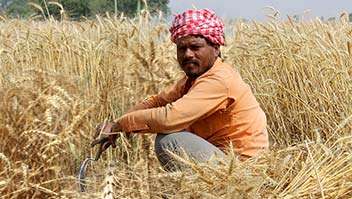
Advisory ArticleAgroStar Agronomy Centre of Excellence
Part 3 - The experiments and results in the hope of the extra 2 Rs.
As a perfect solution to all the problems studied before, the farmer decides to part away with the rain fed and monsoon dependent method of agriculture and tries to implement irrigated agriculture i.e. whole year farming practice. He needs a continuous source of irrigation for that. So he goes for bore well, well or farm ponds or lift irrigation. The farmer tries to make changes in the pattern of agriculture by taking loans from different financial institutions, banks and government subsidies for implementing these schemes. With the changes, new opportunities open up and so do new challenges. In the current and next article, we will analyze the opportunities and challenges one has to face when the rain fed farm is converted into an irrigated one.
All the farmers do not have information about government schemes such as farm pond, drip irrigation, fertilizer management technology by improved irrigation and even if they have, the initial investment needed for these schemes is not feasible for all the farmers. They get subsidy amount only after the scheme is completely implemented. So only those who have capital, can benefit from such schemes.
Universities and government employees should guide farmers about various schemes like these. Farmers study market price of last 2-3 years and then decide some crop and many farmers at the same time decide to cultivate the same crop. As a result of lack of demand or we can say due to over supply, the prices for this produce collapse. If we want to take a recent example, the price of potato at the time of cultivation was Rs. 1500/- per quintal and now when the potato is ready for harvesting, the price is Rs.150/- per quintal. This shows that the maths of demand and supply, sometimes favours the farmers and sometimes it does not. Now, demand and supply, both these things are beyond the control of farmers, however is the onus of the government and marketing bodies.
Let’s take the example of onion. It makes people cry every year, sometimes the customers are at the receiving end and at other times the farmers are the ones who suffer.The production cost for cultivation and selling onion is Rs. 7/- to Rs.9/-. The farmers sell the onion at Rs.- 2/- and suffer heavy losses. The meagre earnings do not even recover the cost of labour for farmers, let alone the capital investment done for the crop and the most important thing is the capital investment done for the land is very high.
As per current market rate, the cost of the land can be around 20 lakhs per acre. What profit an industrialist expects when he invests such an enormous amount in any other business? What is wrong if a farmer expects it the same way? Why can’t the farmers and their family members expect to adapt to swanky lifestyles like industrialists, employees and businessmen? Basically, it is not only the farmer who is dependent on his one acre farm. There is a big chain of people like farm labourers, brokers, businessmen, shop keepers, grocery shop owners, transporters etc. dependent on the farm. But as this chain is invisible, it is never taken into the account. If a business or industry is on the verge of shutting down, government machinery helps it so as not to let it close down.
The main reason behind this is that, the Government has a record of how many labourers work in that business/industry. So government can not afford to lose the employment for so many people and let their families suffer. So it tries to provide capital investment and tries to bail it out. Why such measures are not taken in case of agriculture?
Basically, agriculture is considered as a means for livelihood. Farming does not have the status of business yet.So the farmer who is the king in an agriculture based country and who feeds all, is helpless and we see him begging for loans/loan waivers. The partial treatment given to farmers does not end here. If a farmer goes to the bank asking for a vehicle loan or a personal loan, the bank asks for proof of job or business. If he shows the standard 7/12 extract, then either the loan is denied or the rate of loan changes. The loan which a person having employment or doing a business avails at the rate of 7-8% pa, the same loan a farmer gets at the rate of 11-12% pa. On one hand the bank employees ask for cheaper rates for agriculture produce and buy it at that rate, and on the other hand, they make the farmer pay higher interest rates as he may not be able to repay the loan and it can turn into a bad debt.
To know more, do read the next part,too.
57
0

